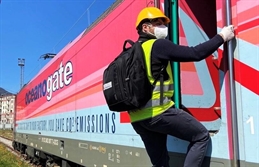
Contship Italia has noted a growing preference for intermodal transport to move goods in light of the coronavirus pandemic, which has brought both air and sea freight to a near standstill.
The Italian container terminal operator said its services remain fully-operational to ensure uninterrupted cargo flow and there is also an increased reliance on the use of rail — which it expects to persist even after the Covid-19 outbreak.
Daniele Testi, marketing and communications director at Contship Italia, said that due to the “dynamic, evolving nature” of government measures as part of the coronavirus response, the availability of different transportation modes has been constantly changing.
“We see backlogs and yard congestion at maritime terminals due to limited truck capacity, while the closing of borders and thorough customs checks have also hindered clearance speed and raised costs,” Testi told Asia Cargo News.
The Contship Italia spokesman noted that with these disruptions, rail freight has become an effective alternative to keep goods moving.
Italy, one of the hardest-hit areas by the Covid-19 outbreak, implemented lockdown measures throughout the country since March 9 — though restrictions were gradually eased starting May 4 with factories and businesses allowed to reopen.
“So far, rail freight has proven to be the most-effective and least-disrupted mode for the flow of goods over long distances. In China, domestic rail freight is currently replacing long-distance haulage previously provided by trucks,” Testi said.
Contship Italia’s inland terminal, Rail Hub Milan, continues to run daily train services to several ports and logistics hubs including La Spezia, Genoa, Ravenna, Padua, Bari, Basel, Zurich, Rotterdam, Vienna, Duisburg and Munich.
While most of its solutions remain at scheduled frequency, Testi said others have been reduced to keep the reliability of the system — reflecting the general decrease of imports from China as well as the reduction in Italian export activities as a consequence of the “non-essential” lock down at a number of production facilities.
Connecting Asia, Europe
Contship Italia welcomed the first train from China (Xian) to Rail Hub Milan on May 12, operated by Rail Cargo Austria.
Testi said that according to the current plan of the Italian container terminal operator, the train will be operated on a weekly basis and, “once the schedule is more established,” Contship Italia will start introducing this direct connection to shippers.
As blank sailings also peaked recently due to the significant drop in demand amid the pandemic, Contship Italia noted that its rail corridor became the more reliable network to transport goods as the sudden changes in routes and services made it difficult for shippers, ports, feeder operators and service providers to follow and adjust to new schedules.
“While air/sea transport is interrupted now, the rail corridor that Contship operates with its operational partners offer dedicated and more reliable rail network reaching all Rotterdam deep-sea terminals and via the terminal we are also connecting to the UK, Ireland, Scandinavia, Russia, etc. via short-sea shipping routes,” Testi said.
On the Italian side, from its Rail Hub Milan, the company runs several rail services to Padua, Bari, La Spezia, Genoa and to the Ravenna port system, the latter providing short sea connections with Turkey, Greece, Egypt, Cyprus, Lebanon and Albania and all major port destinations in the East Mediterranean Sea.
“Operationally, the goods are unstuffed from the reefer containers and directly loaded onto refrigerated trucks that are reaching Northern European areas by road and hopefully by train in the coming future,” Testi said.
Shifting to rail service
Currently, Testi noted the adoption of intermodal is still very slow, with the rail freight market share only accounting for 16.6% of Europe’s freight transport, and only 8% of Italy’s.
“The current situation is in fact a wake-up call for us to rethink how we can improve the modal shift. A better ratio between road and rail will make supply chains more resilient to risk and unforeseen circumstances,” Testi said, noting that intermodal is also a more eco-friendly and efficient logistics solution as well.
At Contship Italia, he said annual throughput capacity handled by rail in La Spezia was expanded to 32% of total throughput, as data show that rail has a significantly lower energy footprint per ton transported compared to other modes, Testi said.
“Not only can our customers take full advantage of a transportation solution that has the smallest impact on the environment, but they can also mitigate their supply chain risks with alternative routing and transport modality,” he added.
While the market is experiencing the issues of modal shift only when there is an urgent need, Testi explained that it “takes time and equipment to build a reliable intermodal solution.”
“It can’t be built overnight. Our industry must think ahead,” Testi told Asia Cargo News.
Outlook for rail
Although the pandemic situation in Europe has stabilized and restriction of movement will gradually relax locally, “cross-border travel restriction will take a little longer to resume back to normal,” Testi said.
“As such, rail transport can move large quantities of goods over long distances with reduced headcount and contactless mode, and will be a preferred choice for the next few months,” Testi said, noting that rail transport would also minimize manpower needed to move goods.
“Consider that on rail transport a train crew – a maximum of two people – moves 40 semi-trailers in addition to the staff (approximately 60) in the intermodal terminals that handle 20 pairs of trains daily. This compares with approximately 800 truck drivers needed to transport the same amount of cargo,” he told Asia Cargo News.
“At the same time, we foresee more and more companies in the logistics sector will begin shifting a significant amount of goods to rail in order to reduce the mobility of people – drivers – across Europe and to reduce the carbon footprint,” Testi added.
By Charlee C. Delavin
Asia Cargo News | Hong Kong




